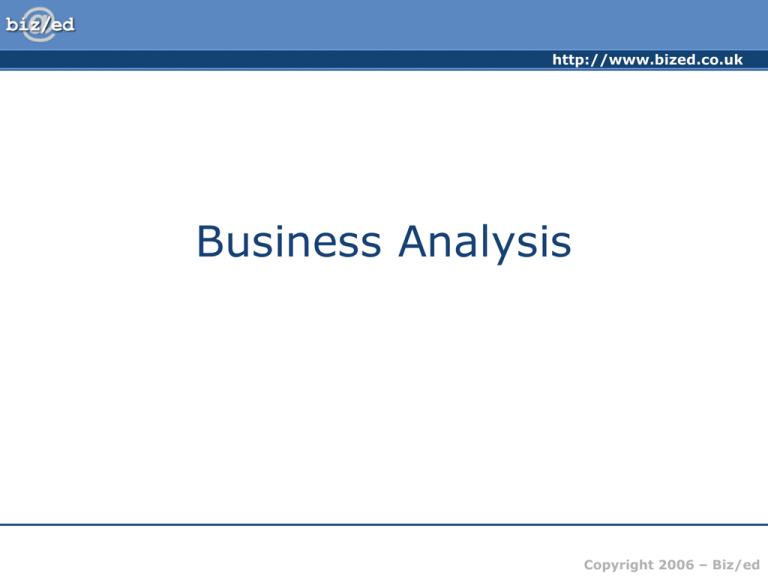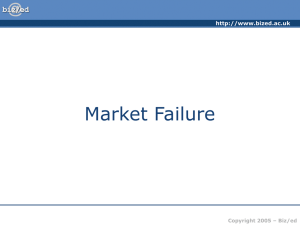Business Analysis - PowerPoint Presentation - Full version
advertisement

http://www.bized.co.uk Business Analysis Copyright 2006 – Biz/ed http://www.bized.co.uk Business Analysis Copyright 2006 – Biz/ed http://www.bized.co.uk Business Analysis • Purpose: – Identify where the business stands in relation to rivals, etc. – Collect and use data to inform business decision making – Identify strengths and weaknesses in the business – Use information to inform strategic planning Copyright 2006 – Biz/ed http://www.bized.co.uk Business Analysis • Method: • Collection of data from a range of sources: • Market research • Past sales data • Market growth data • Specialist analyst data • Secondary data, e.g. Mintel Copyright 2006 – Biz/ed http://www.bized.co.uk Data Copyright 2006 – Biz/ed http://www.bized.co.uk Analysis • Range of methods used to analyse data: • Trends – Growth rates – Nominal – Average • Mean • Median • Mode – Variance • Standard deviation • Range – Time series analysis – Scatter graphs • Correlation Copyright 2006 – Biz/ed http://www.bized.co.uk Trends • Looking for patterns in data collections • Frequency and reliability of trends • Impact of external factors, e.g. seasonal variation, random events, cyclical trends Copyright 2006 – Biz/ed http://www.bized.co.uk Averages • Averages are a measure of central tendency – the most likely or common item in a data series • Calculated through 3 measures: – Mean – Median – Mode Copyright 2006 – Biz/ed http://www.bized.co.uk Averages • Mean = Sum of items in the series/number of items X = Σx x • Median = middle number in a data series – 0.5 (n+1) • Mode = the most frequently occurring value in a data series Copyright 2006 – Biz/ed http://www.bized.co.uk Variance • Averages have limitations – measures of data spread used to assess width • Range – difference between the highest and the lowest value • Standard Deviation – used to measure the variance of the data set from the mean – can highlight how reliable the mean is as being representative of the data set Copyright 2006 – Biz/ed http://www.bized.co.uk The Standard Deviation S= Σ (xi – x )2 n Copyright 2006 – Biz/ed http://www.bized.co.uk Correlation • The degree to which there is a relationship between two or more random variables • The closer the relationship the higher the degree of correlation • Perfect correlation would be where r = 1 Copyright 2006 – Biz/ed http://www.bized.co.uk Time-Series Analysis • Used to analyse movements of a variable over a time period – usually years, quarters, months, etc. • Importance of assessing the: – – – – Trend Seasonality Key moments Magnitude Copyright 2006 – Biz/ed http://www.bized.co.uk Presentation • • • • Graphs Charts Tables Index numbers – Method of showing average changes in large amounts of data – Laspeyres – Uses a base period weighting measurement – Paasche – Uses a current price weighting measurement Copyright 2006 – Biz/ed http://www.bized.co.uk Forecasting Copyright 2006 – Biz/ed http://www.bized.co.uk Qualitative • • • • • Focus groups - a group of individuals selected and assembled by researchers to discuss and comment on, from personal experience, a topic, issue or product User groups – similar to focus groups but consisting of those who have experience in the use of a product, system, service, etc. Panel surveys – repeated measurements from the same sample of people over a period of time Delphi method – calls on the expertise and insights of a panel of experts to help with forecasting – seen as being more reliable than data analysis only – Could be drawn together from around the world as there is no need to have people together at the same time In-house judgements – Use the expertise and judgements of those involved in the business in aiding and making judgements Copyright 2006 – Biz/ed http://www.bized.co.uk Quantitative • Makes use of all the statistical data collected by the firm and by other firms/organisations to help inform decision making – Surveys – Sales data – Impact on sales • Primary data – collected by the firm themselves • Data collected by others and used by the firm, e.g. Office of National Statistics (ONS), Gallup, Mori, Mintel Copyright 2006 – Biz/ed http://www.bized.co.uk Forecasting • Advantages and disadvantages: • Data from several years can give accurate guides to future performance • Statistical techniques can make the data informative and useful • All depends on the quality of the data and the accuracy of the techniques used to analyse the data Copyright 2006 – Biz/ed











